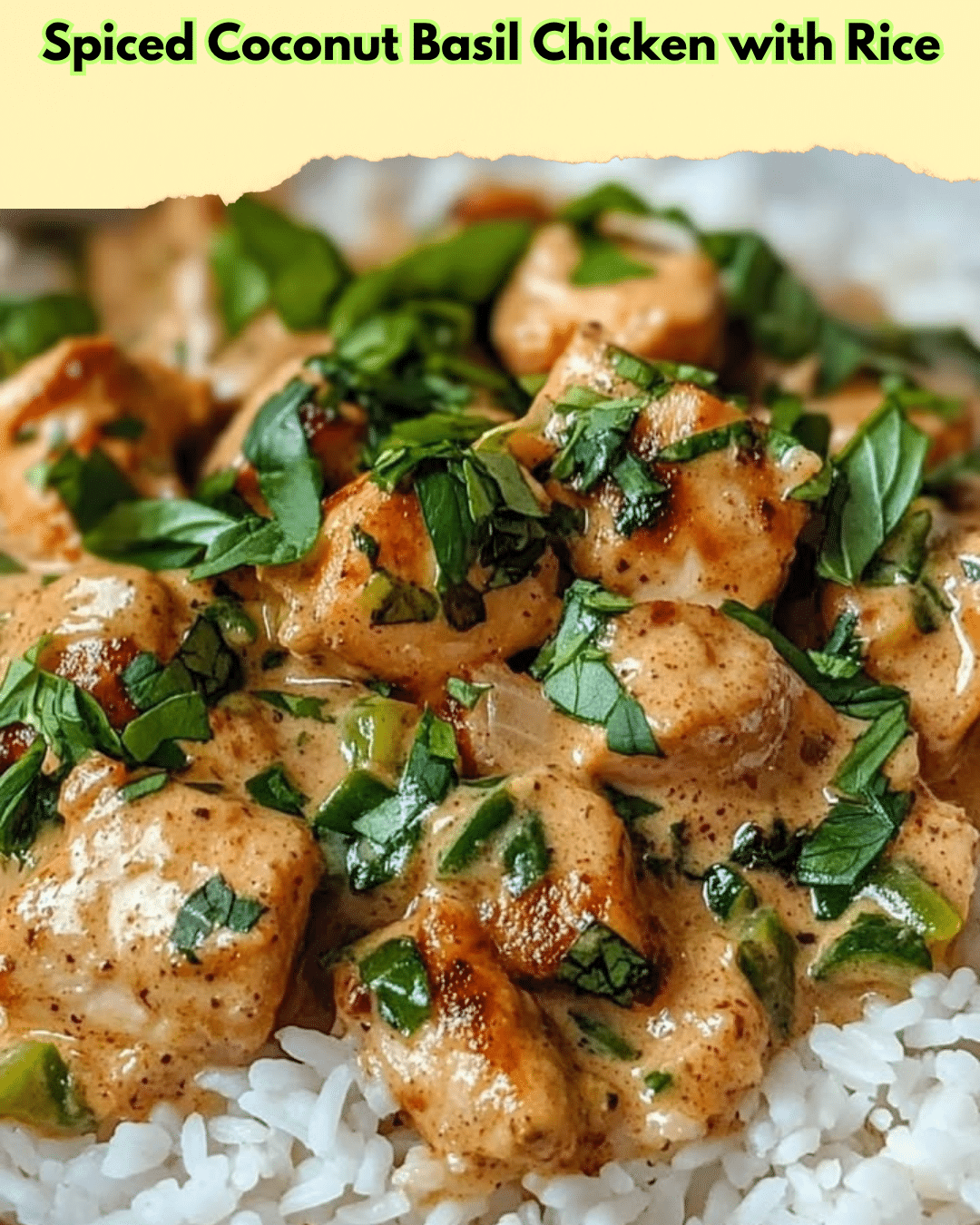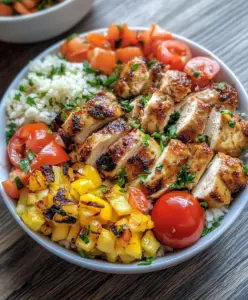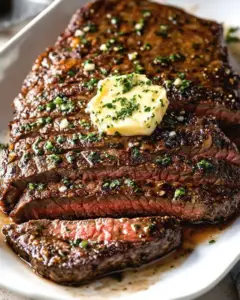Spiced Coconut Basil Chicken with Rice: A Delightful Fusion
Imagine a dish where tender chicken meets the exotic flavors of coconut and fresh basil, creating a harmony of taste and aroma. The Spiced Coconut Basil Chicken with Rice is a culinary masterpiece that effortlessly merges Thai influences with traditional cooking methods. This dish is enriched with the creaminess of coconut milk, the peppery punch of freshly chopped basil, and the warmth of subtle spices, making it both a comfort food and a delightful exotic treat.
The Spiced Coconut Basil Chicken with Rice is not only incredibly flavorful but also visually captivating. As you serve it hot on a bed of fluffy rice, the bright green of the basil and the golden hues of the cooked chicken create a picture-perfect plate. The engaging fragrance of the dish fills your dining area, enticing anyone nearby to take a seat and indulge. Whether it’s a family dinner or an intimate gathering, this dish leaves a lasting impression that goes beyond just flavor.
Quick Recipe Highlights
- Flavor Profile: A delightful blend of creamy coconut with spiced chicken, offering a sweet-savory balance that’s rounded off by fresh basil’s aromatic notes.
- Texture: The chicken is succulent and juicy, complemented by the perfectly cooked rice, while the sauce is smooth and creamy.
- Aroma: A harmonious blend of coconut, basil, and spices that creates an inviting and warm aroma.
- Visual Appeal: The vibrant colors from fresh herbs and spices make this dish not only flavorful but a feast for the eyes.
- Skill Level Needed: Ideal for intermediate cooks who are comfortable with sautéing and simmering techniques.
- Special Equipment: A non-stick frying pan for perfect sear and a rice cooker for fluffy rice.
Recipe Overview
- Difficulty Level: The recipe is moderately challenging, requiring an understanding of timing and seasoning to achieve a balanced flavor profile without overpowering the dish.
- Category: This meal falls under both the dinner and lunch categories, suitable for a nutritious main course.
- Cuisine: Drawing inspiration from Thai and Southeast Asian culinary traditions, it’s a bold fusion of local and exotic ingredients.
- Cost: Relatively economical, as it uses widely available ingredients like chicken, rice, coconut milk, and herbs, with minimal additional costs.
- Season: Best enjoyed year-round, but particularly satisfying in cooler months when the warming spices and creamy sauce are most comforting.
- Occasion: Perfect for casual gatherings, family meals, or as a special Sunday lunch dish.
Why You’ll Love This Recipe
Spiced Coconut Basil Chicken with Rice stands out with its intricate balance of taste, blending the sweetness of coconut milk with a hint of spice and freshness from basil. The tender chicken enhances the dish’s texture, making each bite melt in your mouth. Convenience is key with this recipe. The straightforward steps make it easy to prepare without any rush, and it’s perfect for busy weeknights or cozy weekend dinners.
The nutritional benefit of this dish includes high protein content from the chicken and healthy fats from coconut milk. Basil adds not only flavor but also a dose of essential vitamins. This dish is fantastic for entertaining. Its stunning aroma and rich flavor profile make it ideal for impressing guests. Despite its gourmet impression, the recipe is surprisingly cost-effective, making it accessible for anyone looking to add a touch of gourmet to their home cooking.
Historical Background and Cultural Significance
Spiced Coconut Basil Chicken with Rice is rooted in Thai cuisine, where coconut and basil are staple ingredients. Historically, coconut milk has been used in many Southeast Asian dishes for its rich, creamy texture and ability to mellow out spices. Basil, a herb used since antiquity, adds fresh and aromatic notes, making it a beloved herb in various cultures.
Culturally, the dish reflects a fusion trend prevalent in modern culinary circles, integrating traditional techniques with global ingredients. Thai culinary culture is known for balanced flavor profiles, which are vividly expressed in this dish. Evolution over time has led to regional variations of this recipe, incorporating local ingredients such as lemongrass or chili peppers for added depth.
Ingredient Deep Dive
Chicken, the main protein in this dish, is lower in fat compared to other meats, making it a healthy choice. Its mild flavor pairs well with bold spices and ingredients like coconut and basil. To select the best chicken, look for ones that are firm, plump, and free of any odors.
Coconut milk, derived from the coconut flesh, adds creaminess while keeping the dish dairy-free. Its sweet flavor balances with savory components. Purchase cans with minimal additives and store opened cans in the refrigerator for up to a week. For substitutions, you could use light coconut milk or almond milk for a less rich alternative.
Common Mistakes to Avoid
- Overcooking the chicken: It results in dry, tough meat. Ensure you stop cooking when internal temperatures reach 165°F (74°C).
- Using low-quality coconut milk: This alters the texture and flavor. Opt for high-fat content coconut milk for the best results.
- Not simmering the sauce: It concentrates the flavors and thickens the consistency.
- Skipping the fresh basil: Dried herbs won’t provide the same vibrant freshness.
- Incorrect rice cooking: Follow exact water to rice ratios for fluffy results.
- Underoiling the pan: This can result in uneven cooking or sticking.
- Rushing the cooking process: Allow ample time for each step to ensure a perfectly cooked dish.
- Not adjusting spices: Taste and season the dish according to personal preference.
Essential Techniques
Searing is crucial as it locks in the chicken’s juices, providing a caramelized exterior that enhances flavor. Master this by ensuring your pan is hot, gently pressing the meat against the pan’s surface. Avoid moving the chicken until it naturally releases from the pan, ensuring each piece is evenly cooked for a delightful finish.
Simmering the coconut milk and spices allows them to meld, creating a unified flavor profile. This technique requires patience and low heat to prevent curdling or over-reduction of the sauce, delivering a smooth, rich consistency desirable in this dish. Recognizing the right texture comes with experience; when the sauce coats the back of a spoon, it’s perfect.
Pro Tips for Perfect Spiced Coconut Basil Chicken
Always use high-quality chicken to ensure tenderness. Fresh basil should be added last to preserve its vibrant aroma and color. Avoid substituting strong herbs for basil, which might overshadow the delicate balance of flavors. Coconut milk must be well-stirred before use to integrate the cream and liquid.
When cooking rice, rinsing it under cold water helps in removing excess starch, resulting in non-sticky, perfectly separate grains. Resting the dish for a few minutes before serving allows flavors to meld and enhances the overall taste. Lastly, fresh lime juice adds a zesty lift to the dish before serving, enhancing its flavor profile.
Variations and Adaptations
Regions like Indonesia might incorporate lemongrass, infusing the dish with citrusy notes. During summer, adding fresh mangoes offers a sweet, tropical twist, while winter versions might include hearty root vegetables. Adapting for dietary needs, use cauliflower rice for low-carb alternatives.
For a vegan version, substitute chicken with tofu, which soaks up the flavors beautifully. If you’d prefer a spicier kick, increase the amount of chili flakes or add chili sauce to adjust heat levels. Texture fanatics can introduce chopped nuts for a crunch, while presentation-focused cooks can garnish with edible flowers or microgreens.
Serving and Presentation Guide
Plate the rice first, creating a bed for the chicken and sauce to rest upon. A sprinkle of fresh basil leaves or chopped green onions on top provides color contrast and freshness. Traditional accompaniments might include a light salad or pickled vegetables, balancing the dish’s richness.
Modern serving suggestions include presenting in individual bowls for an attractive plated dessert. Optimal temperature serving ensures the coconut sauce’s richness is felt without being overly heavy, with care taken to limit portions to avoid overwhelming. This dish is as much about visual aesthetics as it is taste.
Wine and Beverage Pairing
A crisp white wine like a Sauvignon Blanc complements the coconut and spices, while a light beer can offer a refreshing contrast. For non-alcoholic options, coconut water or a basil-infused lemonade enhances the dish’s core flavors without overpowering. Serve beverages at a cool temperature to refresh the palate.
For coffee lovers, a light roast with floral notes pairs surprisingly well, while a mild Jasmine tea complements the herbal basil notes. Consider serving in delicate glassware to enhance the dining experience and keep beverages chilled to complement the dish’s warmth.
Storage and Shelf Life
Store leftovers in an airtight container in the refrigerator for up to three days. Coconut’s fat content recommends cooling before sealing to avoid condensation. Use shallow containers for quicker cooling, preventing bacterial growth. Signs of spoilage include sour smells or change in color.
Reheat on a stovetop over medium-low heat, stirring continuously to maintain a smooth consistency. Microwaving is an option but may result in uneven heating. If freezing, pre-portion before freezing, with a shelf life of up to a month. Always thaw thoroughly before reheating.
Make Ahead Strategies
Prepare ingredients a day in advance, storing components separately to maintain freshness. Rice can be cooked a day before and reheated with a splash of water to steam. Sauces stored separately retain consistency better, with fresh elements like basil added just before serving.
If freezing, assemble but cook rice fresh on the serving day. Reheating should be slow and consistent, avoiding harsh temperature changes that could affect texture. Fresh lime juice and basil incorporate best when freshly added, enhancing the final flavor profile.
Scaling Instructions
Halving the recipe is straightforward, maintaining cooking times but reducing ingredients by half while concentrating flavors more effectively. Doubling or tripling increases portions but requires larger equipment ensuring even cooking. Timing may need adjustment, especially for larger quantities.
Storing larger quantities needs careful portioning and temperature control to preserve taste. Always scale spices and seasonings with care to avoid overpowering the dish and ensure adequate space for cooking for even heat distribution.
Nutritional Deep Dive
High protein content from chicken contributes to muscle building and repair. Coconut milk adds beneficial MCTs (medium-chain triglycerides), fostering energy and metabolic support. Basil offers a source of vitamins A and C, enhancing immune defenses and vision.
Portion sizes impact caloric intake; maintaining balance with vegetables optimizes nutrition without overindulgence. Health benefits include low trans-fat content and a good balance of carbohydrates from rice. This dish, when portioned correctly, supports weight management while offering a delightful sensory experience.
Dietary Adaptations
For gluten-free needs, ensure rice is not cross-contaminated by wheat products. Substitute coconut amino for soy sauce to ensure a gluten-free dish. Dairy-free inherently due to coconut milk, making it suitable for lactose-intolerant diets.
Vegan versions skip animal products, offering plant-based protein through tofu or tempeh and maintaining flavor with coconut milk and fresh herbs. Low-carb dish variants use alternatives like cauliflower rice without losing out on taste and texture satisfaction.
Troubleshooting Guide
If the dish lacks flavor, it may require a balance of seasoning; add lime juice or extra herbs to enhance. Texture issues often stem from improper coconut milk integration or overcooked chicken; ensuring proper timing and heat are key.
Adjusting heat levels to avoid burning happens by regularly stirring, while ingredient substitution requires careful evaluation of flavor profiles (e.g., using almond rather than coconut milk can alter taste). Timing impacts are managed by understanding that complexity improves with patience.
Recipe Success Stories
Readers have shared numerous successes, such as infusing saffron for a luxurious color and unique taste, or transitioning it into a casserole paired with baked vegetables. Variations like smoked paprika or chili paste have been community favorites, enhancing depth without overshadowing the coconut milk’s sweetness.
Reader adaptations like using jasmine rice add an aromatic twist, while feedback often involves creative photography tips using natural light to highlight the dish’s vibrant presentations. Suggestions often bring out individual personal touches, becoming signature dishes within varied home kitchens.
Frequently Asked Questions
Yes, turkey is a lean alternative and cooks similarly; ensure it’s moist by not overcooking.
What if I dislike coconut milk?
Almond or soy milk can substitute, though the richness will differ. Adding coconut essence might retain some flavor.
How do I store leftovers?
Quickly cool at room temperature before refrigerating in airtight containers to maintain freshness.
Can this dish be made ahead?
Ingredients can be prepped in advance, with final assembly closer to serving time for best results.
Is this dish spicy?
It can be adjusted; control by regulating chili levels, ensuring it suits your tolerance.
What kind of rice works best?
Jasmine or basmati are recommended for their fluffiness and ability to soak up flavors efficiently.
Does this recipe freeze well?
Yes, it freezes beautifully, retaining taste if stored correctly and reheated gently.
Can I add vegetables?
Absolutely, adding bell peppers or spinach provides nutrition and color, blending seamlessly.
Can this dish fit into a keto diet?
Substitute rice with cauliflower rice, and ensure coconut milk is full-fat for a balanced keto meal.
What herbs can replace basil?
Cilantro or mint offers a refreshing taste, though altering the final flavor significantly. It’s best to experiment based on personal preference.
Can the recipe be doubled?
Yes, but attention to seasoning and cooking times is critical as quantities increase to retain quality and taste.
How do I thicken the sauce?
Cooking longer over low heat thickens naturally, while arrowroot or cornstarch can offer quicker results.
Additional Resources
Explore related recipes like Thai Green Curry for similar flavor profiles, or delve into technique guides on handling Asian herbs and spices for deeper culinary insights. Ingredient information including health benefits of coconut and basil can aid understanding their central role.
For seasonal variations or further inspiration, consider recommended equipment like a quality non-stick pan ensuring even cooking or rice steamer guides maximizing efficiency. Engage with seasonal adaptation resources that encourage utilizing fresh local ingredients ensuring sustainability and peak flavors in your home cooking.
Print
Spiced Coconut Basil Chicken with Rice
Description
A flavorful and aromatic chicken dish simmered in a spiced coconut sauce, complemented with fresh basil and served over fluffy rice.
Ingredients
For the Crust:
- 2 tablespoons olive oil
- 1 pound chicken breast, diced
- 1 onion, chopped
- 2 cloves garlic, minced
- 1 tablespoon curry powder
- 1 can (14 oz) coconut milk
- 1 cup basil leaves
- Salt and pepper to taste
- 2 cups cooked rice
Instructions
1. Prepare the Crust:
- Heat olive oil in a large skillet over medium heat. Add chicken and cook until browned.
- Stir in onion and garlic, cooking until fragrant. Add curry powder and mix well.
- Pour in coconut milk, bring to a simmer, and cook for 15 minutes. Add basil leaves, salt, and pepper. Serve over rice.
Notes
You can customize the seasonings to taste.




